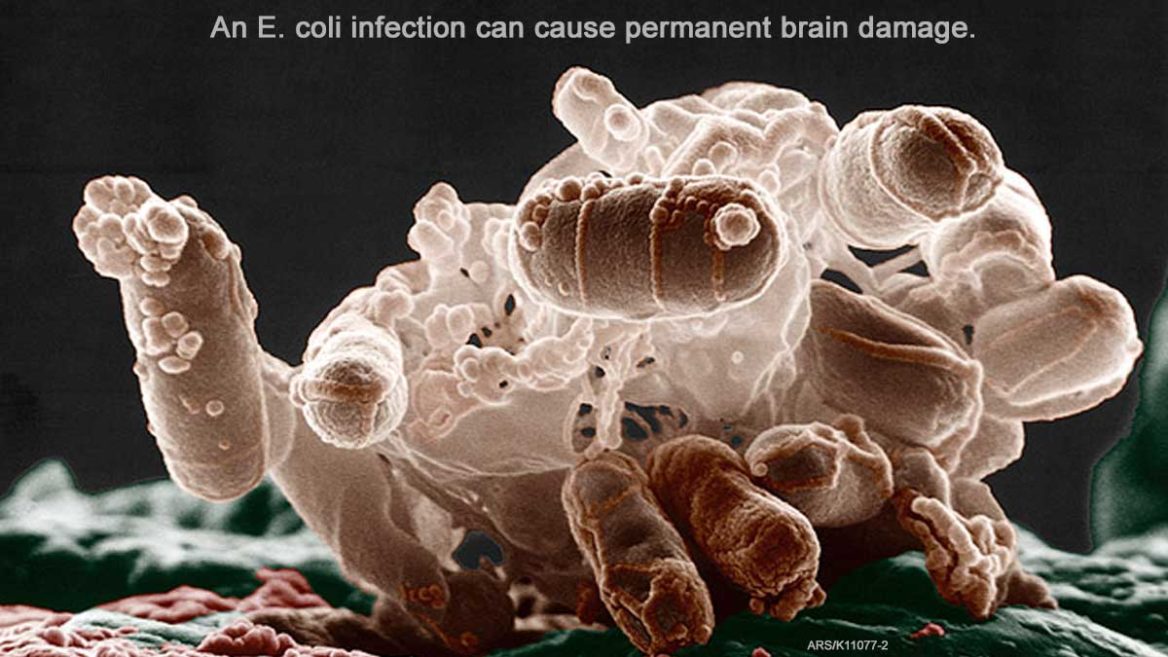E. coli poisoning can cause permanent brain damage. Even little children with E. coli infections can have strokes and suffer permanent brain damage or death. In fact, in patients with E. coli infections, “brain involvement is the most frequent cause of fatalities.”1 Possible adverse events include seizures, stroke, coma, edema (swelling of the brain), and encephalopathy.
Permanent damage can include hemiplegia (weakness of the left or right side of the body), cortical blindness (total or partial loss of vision) and psychomotor impairment (slow movements, thought processes, and speech). Even in cases where there appears to be full recovery, these patients may have some learning problems.2
E. coli can also cause hemolytic uremic syndrome (HUS) and thrombotic thrombocytopenic purpura (TTP), both of which can involve the brain. HUS is characterized by damage and destruction of the red blood cells, which leads to a lower than normal number of red blood cells (a condition called anemia), blood clots, and damage to blood vessel walls. E. coli-TTP occurs when too many platelets are destroyed, allowing for the creation of tiny thrombi (blood clots) in blood vessels throughout the body, but particularly in the central nervous system (CNS) and kidneys.
E. coli and Seizures
Seizures are often the first sign that an E. coli infection has injured the brain. Seizures can occur at any point, even after an apparent recovery. The mortality rate for patients who experience seizures and/or coma is higher than for those who do not suffer this complication.
Seizures are usually brief and easy to control, but a child with HUS may experience status epilepticus, which is a prolonged seizure or a series of seizures where the child does not regain consciousness.
E. coli and Brain Damage from Stroke
There are two categories of stroke, ischemic and hemorrhagic:
- Ischemic are either thrombotic or embolic. With this illness, most are thrombotic strokes, which are caused by a thrombus (blood clot) that develops in the arteries supplying blood to the brain. This is also referred to as cerebral thrombosis or cerebral infarction.
- Hemorrhagic occur when a blood vessel in the brain leaks or ruptures. It is caused by the associated renal failure because toxins the body should have excreted in urine get into the blood and circulate throughout the body. These toxins can damage the brain and cause a stroke.
E. coli and Coma
The toxins in the blood stream that build up because of the renal failure can also cause a coma. People in comas can display varying degrees of consciousness. The Glasgow Coma Scale is used to determine the level of unconsciousness. The total score range is 3 to 15 — the higher the score (the lower the number), the less responsive the patient. A patient with a score of 3 to 8, the most severe, is generally considered to be in a coma.
A medically induced coma may be applied for E. coli victims with uncontrollable seizures.
E. coli and Encephalopathy
Encephalopathy is a term used when there is brain disfunction or alteration. This is usually related to the uremia. When uremia is the cause of the brain dysfunction, the condition is called uremic, metabolic, or toxic-metabolic.
Food Safety Law Firm
Our E. coli law firm has a national reputation in the area of food poisoning litigation and have been interviewed and quoted by The New York Times, The Wall Street Journal, USA Today, Lawyers USA, and others. To contact an E. coli lawyer for a free consultation, call toll-free at 1-888-377-8900 or submit the online consultation form.
1. Trachtman, Howard, et al. “Renal and neurological involvement in typical Shiga toxin-associated HUS.” Nature Reviews Nephrology 8.11 (2012): 658-669.
2. Schlieper, A. et al. Neuropsychological sequelae of hemolytic uremic syndrome. Investigators of the HUS Cognitive Study. Arch. Dis. Child. 80, 214–220 (1999).
For additional information, see “E. coli-HUS Renal and Brain Damage.”


